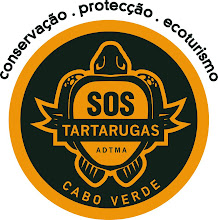Hardly believing their eyes, they uncovered the nest and found several hatchlings still inside.
In general, the nesting season starts in mid-June and the first hatchlings are born in the middle of August. For this nest to have hatched the turtle must have nested in late April or early May - two months earlier than expected! Nobody knows why this has happened but you could speculate that it could be due to the individual turtle or even to climate change.
There were 72 hatched eggs inside the nest and of those that were born many went in the wrong direction possibly due to the light of the houses from Santa Maria which disorientates turtles.
After a long search the dedicated Rangers found five more baby turtles which were lost in the dunes and these were then released into the sea.
 |
Filhotes de tartarugas nascem 2 meses antes do tempo! Turtles born 2 months earlier than expected! |
June 29, inesperadamente, o primeiro ninho de Tartarugas Caretta caretta na praia de Costa Fragata, na Ilha do Sal.
As tartarugas nasceram de um ninho que não tinha sido identificado. De uma forma geral, a temporada de desova ocorre em meados do mês de Junho e os primeiros filhotes nascem a meio do mês de Agosto, já esta tartaruga subiu para desovar no início do mês de Maio, dois meses antes do esperado! Não sabemos a razão pela qual isto aconteceu mas poderá ter a ver com alteração de comportamento desta tartaruga em particular ou com alguma alteração no clima, no entanto não temos dados concretos que confirmem estas suspeitas.
O ninho foi detectado por Rangers da SOS Tartarugas enquanto faziam a patrulha matinal à procura de rastos de tartarugas adultas, ficando surpresos quando encontraram rastos de tartarugas bebes. Foram contabilizados 72 ovos eclodidos, 59 ovos não eclodidos e 5 nati-mortos, o que se traduz numa taxa de sucesso de 52,94%.
Os filhotes emergiram durante a noite, quando os rangers chegaram, por volta das 6 horas da manhã, detectaram inúmeros rastos, sendo que alguns iam na direcção contrária ao mar. Mais uma vez a iluminação das residências de Santa Maria provocou a desorientação dos filhotes. Após uma busca foram encontrados 5 filhotes, que andavam perdidos nas dunas, e foram libertados no mar.






No comments:
Post a Comment